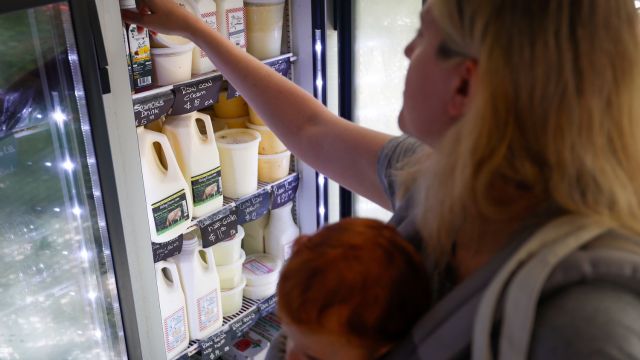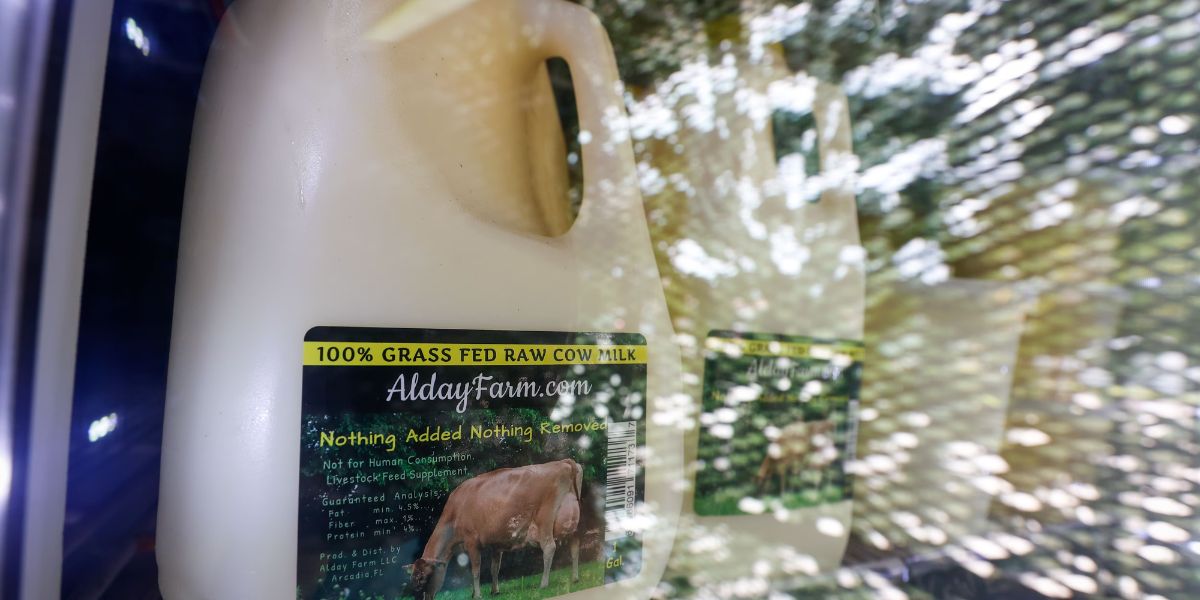BELLEAIR BLUFFS —
Mateo Barbagelata visits coffee shops with a container of raw cow’s milk and requests that the baristas add it to his lattes.
The words “RAW MILK IS NOT A CRIME” are decalmed onto his laptop.
The 25-year-old Barbagelata stated, “Raw milk for us is a lifestyle.”. The Lakeview Farm Store, a vegetable stand in Clearwater, is owned by his family and sells raw dairy goods.
Barbagelata continues to drink raw milk despite public health officials’ warnings that a strain of avian flu is quickly spreading among dairy animals in areas such as Texas and Michigan.
Apparently, a lot of other Floridians feel the same way.
Raw milk may contain live avian flu virus and might spread the illness further, according to the state Department of Agriculture and Consumer Services earlier this year. Nevertheless, local businesses have informed the Tampa Bay Times that raw milk demand has been consistently high and even increasing over the past few years.
After relocating from Argentina three years ago, the Barbagelata family purchased Lakeview Farm Store. They started off selling roughly 20 gallons of unpasteurized cow’s milk weekly. Now, according to Barbagelata, it sells about 300.

According to him, “every day we’re having new customers” who buy raw milk for the very first time. The public is beginning to realize something.
Vicky Webster, 48, of Happy Tails Farm in Brooksville, said that producers of unpasteurized dairy products are finding it difficult to match the demand. In addition to selling raw goat’s milk, her company sources unpasteurized cow’s milk from other farms in Florida.
SEE MORE –
Now Taste Is One! These Costco’s Ice Cream Outshines Name Brands, Customers Say
Health officials are already under pressure from the public’s mistrust and the newest infectious disease outbreak, the COVID-19 pandemic, and the growing raw milk industry is adding fuel to the fire.
To illustrate her point, Webster has stated her belief that the current avian flu epidemic is a “conspiracy type of thing” orchestrated by the state.
Raw milk from an infected cow may expose customers to the avian influenza virus, H5N1, however the exact danger is still unknown.
No one knows how much of the virus would be needed to make someone sick or if it could induce an infection if consumed in unpasteurized milk.
However, studies have shown that mice given droplets of raw milk from infected cows had lethargy and elevated levels of the virus in their respiratory organs. This raises worries regarding the potential consequences for people.
So far, the virus has been found in over 160 herds across 13 states, and federal officials started reporting instances in dairy cattle at the end of March. No infection has been confirmed in Florida as of yet.
A pandemic might be set off if the H5N1 virus were to evolve and swiftly infect people, according to experts. Colorado, Michigan, and Texas are home to four dairy farmworkers who have all suffered from minor infections. According to Nicole Martin, an assistant research professor in dairy foods microbiology at Cornell University, they contracted the virus through “direct contact” with infected cows.
Experiments carried out by the U.S. Food and Drug Administration and Department of Agriculture indicate that pasteurization, the process of heating milk to destroy hazardous bacteria including listeria, salmonella, and campylobacter, neutralizes the virus. When a cow is sick or there is pollution in the surroundings, pathogens might enter the milk.
The risks of drinking unpasteurized milk have been known to public health officials for some time, and the CDC has just issued a new warning against consuming raw milk that contains the live H5N1 virus.
According to the organization, some of the symptoms of food poisoning that can be obtained from drinking raw milk include vomiting, cramping in the stomach, and diarrhea. Severe illness is more likely to occur in young children, the elderly, pregnant women, and people with compromised immune systems.
Research demonstrates that over a twenty-year period, 2,645 illnesses, 228 hospitalizations, and three fatalities were recorded by health departments across the country as being associated with unpasteurized milk. Even though there were 33 hospitalizations, the number of deaths and diseases linked to pasteurized milk was identical.
A fatal case of listeria, which was associated with raw milk from a Pennsylvania producer, occurred in Florida ten years ago.
The state agricultural agency reports that unpasteurized milk cannot be sold to the general public in Florida. However, for those who are familiar with the area, raw cow’s milk is readily available for purchase.
I’ve walked away.
Florida farms clearly state that their unpasteurized milk is meant just for dogs and not for human use. A reporter for the Times shopped for raw milk in 1-gallon jugs at stores in the Safety Harbor and Carrollwood areas. One costs $14.99 and the other $16. A “livestock feed supplement” was the advertised use of one.
According to Barbagelata of Lakeview Farm Store, which sells raw dairy products to as many as 250 customers weekly, the decision to drink it is ultimately up to the consumers.
State agriculture department spokesperson Jessica Kelleher admitted in an email that the agency “does not have authority to enforce the personal use of such products” if a business isn’t selling raw milk in violation of Florida law or regulation.
The number of stores in Tampa Bay and the rest of the state that sell raw milk is unknown. Although it is sold by local health food stores, it is not sold by larger chains such as Publix and Walmart.
Researchers from the Food and Drug Administration found that 4.4% of adults in the US admitted to drinking unpasteurized milk annually, based on data from 2016 and 2019.
Data from NielsenIQ, a worldwide research organization that measures retail purchases but not those directly from farmers to consumers, shows that raw cow’s milk sales have been on the rise, but they still make up a small percentage of total milk sales on a national level.
The company gave the Times figures showing that unpasteurized cow’s milk sales in the United States were over $2.5 million for the year ending June 29, an increase of 6% from the previous year. Out of a total of $11.5 billion, that is hardly a fraction.
Last year, Georgia became one of several states that began to permit the sale of unpasteurized milk for human consumption. As far as the FDA is concerned, just 20 states have outright banned the sale of raw milk within their borders, and Florida is one of them.
However, it seems like things are going swimmingly in Tampa Bay.
Mike Alday, 69, milks over 200 grass-fed cows on his 640-acre dairy farm in Arcadia. “I’m sold out right now for the next two years,” he said. You may find his raw milk at Lakeview Farm Store and other local spots.
Although he refused to provide the exact amount, Alday did tell the Times that he sells thousands of gallons weekly. He claimed that stores all the way from Miami to Orlando carry his wares.
He claimed that demand is soaring.
“I think it’s better for you”
The influencer Paul Saladino, who has 2.2 million Instagram followers, is a major reason why unpasteurized milk is becoming so popular, according to Barbagelata.
According to Barbagelata, Saladino, who calls himself a “Double Board Certified MD” and posts on TikTok, has been quite popular in the past two or three years. He promotes what he terms a “animal-based diet” that includes raw dairy, fruit, honey, and organs. These foods “can reverse and prevent disease, as well as unlock our most powerful forms,” according to Saladino’s website.
As a result of Saladino’s advocacy for raw milk, Barbagelata claims that other, less popular influencers are beginning to follow suit. He estimated that young, athletic people made up around 60% of Lakeview Farm Store’s raw cow’s milk customers.
According to Webster of Happy Tails Farm, raw milk information is more readily available than in the past, and like-minded individuals are networking through social media.
There are a lot of health claims made regarding unpasteurized milk online. Some of these claims include that it helps with digestion, reduces allergies, and has more protein and vitamins than pasteurized milk.
According to Dennis D’Amico, an associate professor at the University of Connecticut who focuses on the safety of dairy products, the majority of the assertions made by those who advocate for raw milk lack scientific proof or are simply unfounded. He mentioned that certain vitamins, particularly vitamin C, can be diminished in milk due to pasteurization. However, he did say that since milk already contains very little vitamin C, any decrease would have no noticeable impact on someone’s health.
However, some who consume unpasteurized cow’s milk maintain that it is more nutritious and hold a strong mistrust of public health authorities.
In order to demonstrate the safety of raw milk, Barbagelata claimed to have consumed one gallon daily for two months. According to him, he felt revitalized and didn’t get sick. He further mentioned that since he started taking it consistently in 2021, his skin has become clearer.
According to Barbagelata, personnel from Lakeview Farm Store go to the farms where raw milk is sold to make sure the animals are well taken care of and the premises are clean. (Martin from Cornell University explained that any animal, no matter how clean or healthy it looks, could be carrying a pathogen and shedding it without showing any signs.)
The goods are authentic, according to Barbagelata.
Creamier and “I feel it’s healthier”—that’s what Webster had to say about raw goat and cow milk. She made it clear that she was only sharing her story and not advocating for the consumption of raw milk.
Olivor Heritage Farms owner John Roberts, 54, of Dover, likewise drinks raw milk and claims he isn’t concerned about the H5N1 virus. He warned that the two foods most likely to cause food poisoning are raw shellfish and uncooked greens.
According to him, many people want to break away from the “commercial food system” and instead purchase from local sources, where they can meet the individuals who manufacture the products, and public trust in organizations like the CDC is low.
Researchers encounter obstacles when trying to educate people about unpasteurized milk, as Martin admitted.
“Even though I might say, ‘OK, there’s this increased risk,’ as a scientist, what does that mean for the average consumer who has probably been drinking raw milk or has in the past and didn’t seem sick?” she asked.
